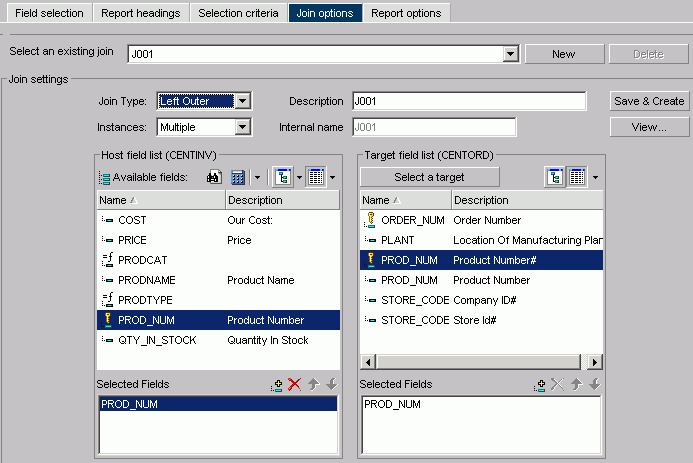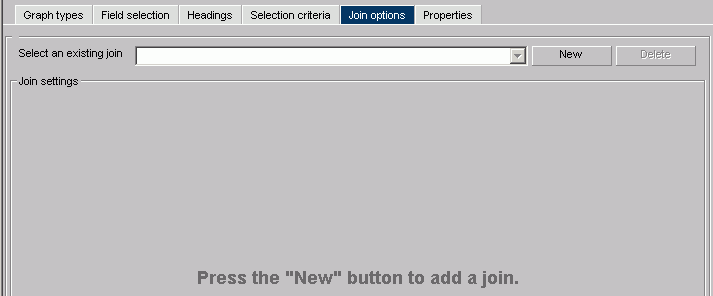The Join Options tab is used to create joins.
x
Reference: Join Options Tab: Existing Join
The
following image shows the Join Options tab with an existing join
selected.

-
Select an existing join
- Use the drop-down list to select the join with which you
want to work. x
-
Delete
- Click to delete the join.
-
New
- Click to create a new join.
Join Settings:
-
Description
- Enter a description for your join.
-
Internal name
-
WebFOCUS assigns an alphanumeric name for the join, for example
J001.
-
Unspecified
- Select from the Join Types drop-down list to indicate neither
an inner or left outer join.
This option
is selected in the Join properties when a join that was created
in an earlier release is opened. In prior versions, the defaults
for join type and other operators were assumed and not specified
in the generated code. Since the Graph Assistant cannot determine
the type of join that was created and if there were other commands set
to control the join, select the appropriate options (Inner Join,
Left Outer Join, Multiple Instances, Single Instances) from to upgrade
the generated code.
-
Inner Join
- A join that results when a report omits host rows that lack
corresponding cross-referenced rows.
-
Left Outer Join
- Extends the results of an Inner Join and retrieves records
from both host and cross-referenced tables, including all records
from the left table (host) and any records from the right table
(cross-referenced) where the condition values match. If there are
no matching values in the cross-referenced table, the join still
retrieves records from the host table.
-
Multiple Instance (formerly Non Unique)
- A one-to-many join structure that matches one value in the
host data source to multiple values in the cross-referenced field.
Joining employee ID in the employee data source, of your company,
to employee ID in a data source that lists all the training classes
offered by that company would result in a listing of all courses
taken by each employee, or a joining of the one instance of each
ID in the host file to the multiple instances of that ID in the
cross-referenced file.
-
Single Instance (formerly Unique)
- A one-to-one join structure that matches one value in the
host data source to one value in the cross-referenced data source.
Joining an employee ID in an employee data source to an employee
ID in a salary data source is an example of a unique join. x
-
Save & Create
- Once you have selected your host and target fields, clickSave
& Create to create the join. x
-
View
- Click to view the syntax of your join, which displays the
code sent to the WebFOCUS Reporting Server to validate
the join, but may not be the same code required to run the report.
This is the case for a DEFINE based JOIN where only the JOIN statement
is displayed for validation, but both the JOIN and DEFINE statements
are needed when the report is run.
Host Field List:
x
-
Define icon
- Click the Define icon to select: New define field, Edit define
field, or Delete define field. If you select the New define field
or Edit define field, the Define field creator dialog box opens
where you can create or edit a defined field. x
-
Tree icon
- Displays a tree structure of field names by segment with,
segment, alias, title, description, and format information below
the tree. Individual field information appears when you click the
field.
-
List icon
- Displays a list of all field names with information that
you select from the adjacent arrow that opens a drop-down list:
name, alias, title, remarks, format, description, segment, and file
name. You can also choose to sort by file order. x
-
Add button
- Adds a field. x
-
Remove button
- Removes a field. x
x
-
Move Up or Move Down buttons
- Moves the position of the field within the join.
Target Field List:
x
-
Select Target
- Click to select a target Master File. x
-
Tree icon
- Displays a tree structure of field names by segment with,
segment, alias, title, description, and format information below
the tree. Individual field information appears when you click the
field.
-
List icon
- Displays a list of all field names with information that
you select from the adjacent arrow that opens a drop-down list:
name, alias, title, remarks, format, description, segment, and file
name. You can also choose to sort by file order. x
-
Add button
- Adds a field. x
-
Remove button
- Removes a field. x
x
-
Move Up or Move Down buttons
- Moves the position of the field within the join.

